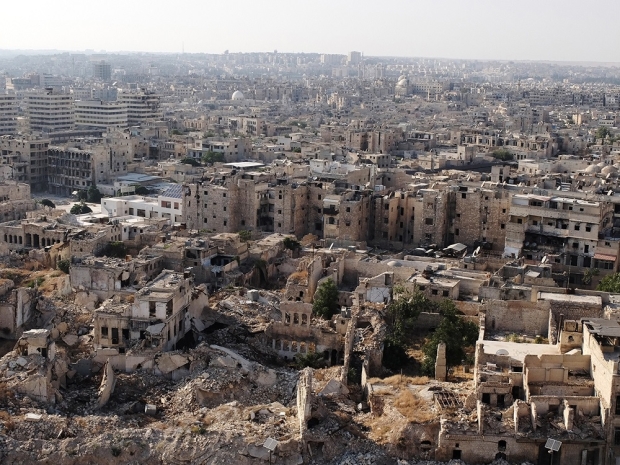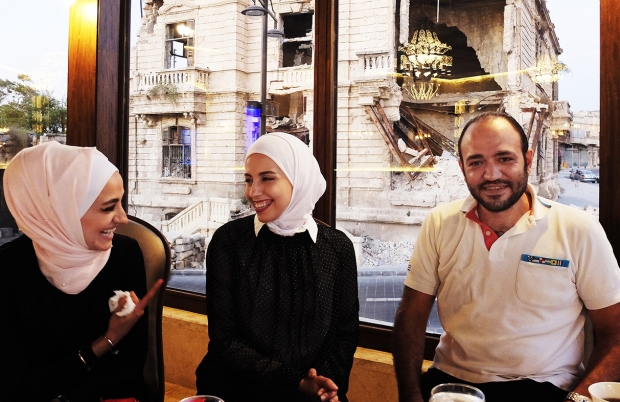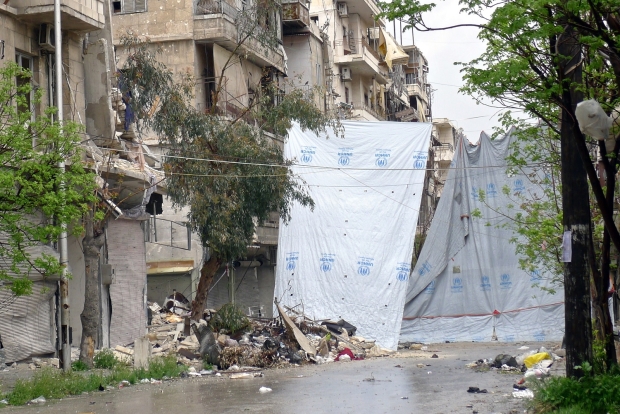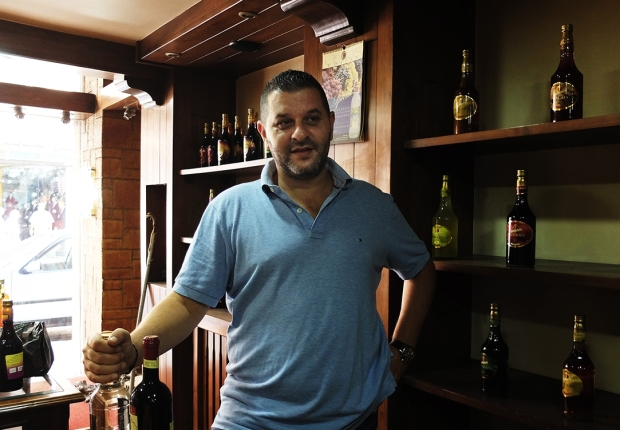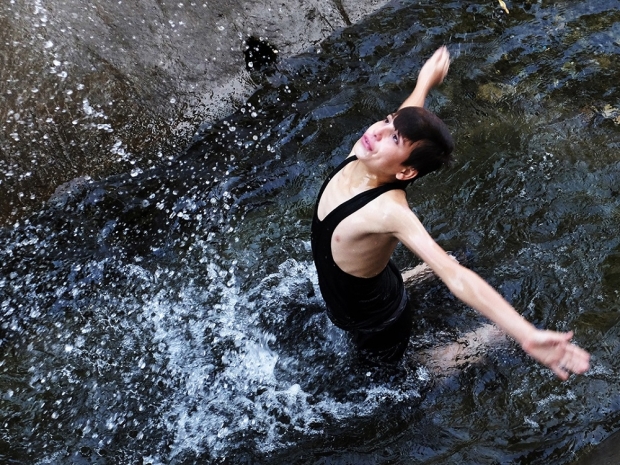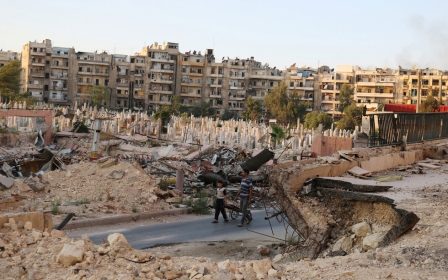'Thank God you survived the war': How life returned to Aleppo's Old City
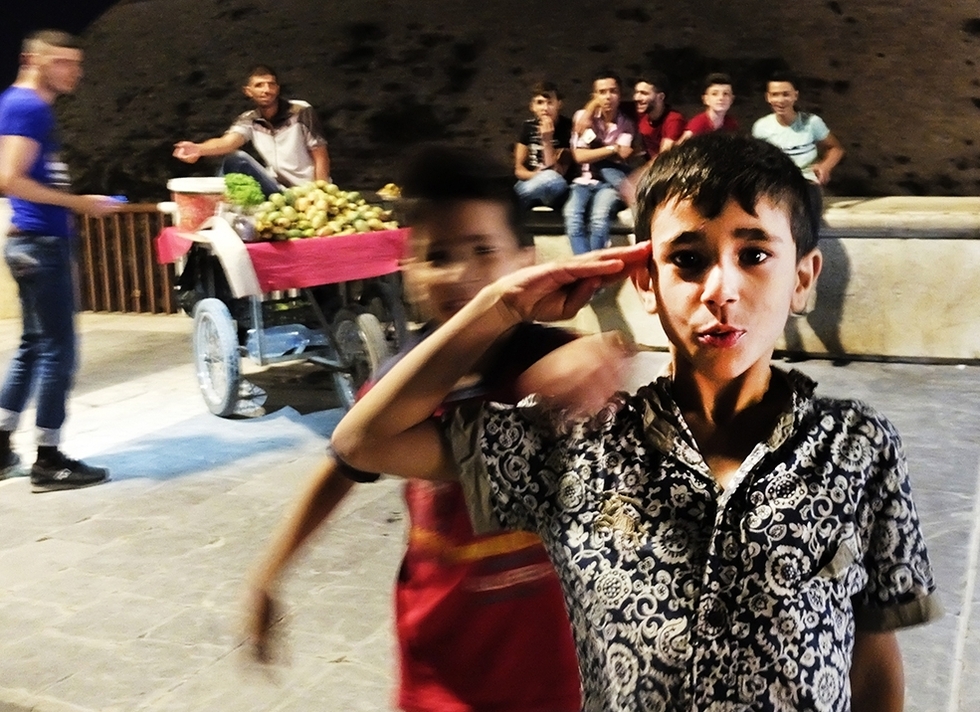
Editor’s note: This piece is one of a series to mark the second anniversary of the evacuation of eastern Aleppo on 15 December 2016. Zouhir Al Shimale writes about life for those who can never return in "'It is worse than death': The Aleppo families who live in exile."
ALEPPO, Syria - In the heart of Aleppo Old City, the impressive medieval citadel once again glows with simple night-time illuminations.
Below, the pavement bustles with families who pause for selfies in front of a large metallic #Believe in Aleppo sign, or sip tea and smoke shisha pipes at overpriced cafes.
Less than two years after Syrian army forces regained control over central Aleppo, cafes and restaurants have already been rebuilt.
Off-duty soldiers and only sons, to whom Syria’s ongoing compulsory military conscription does not apply, lark around, trying to make eye contact with girls in high-heels.
A young man takes a running leap, then launches himself onto a mule offering rides for children. He canters off confidently at an unlikely speed, weaving between families and youths on bicycles festooned with battery-powered LED lights.
Life amid rubble
Present-day Aleppo is in contrast to the war-torn city which dominated world headlines, before the conflict between government forces and rebels based in eastern neighbourhoods finally ended in December 2016.
An estimated 30,000 people were killed during the four-year conflict across the city and surrounding region, which was once Syria’s industrial and financial hub.
Hundreds of thousands more were injured, bereaved and forced to flee their homes.
The citadel - a 13th-century Unesco World Heritage site - was surrounded by rebel forces but never taken. For two years, Syrian army soldiers under siege inside the citadel defended the site, surviving with air-dropped supplies of weapons, food and ammunition.
Locals say that on one occasion rebels, having reopened extensive ancient tunnels unused for centuries, ambushed solders in the middle of the castle.
Guides now offer Arabic-language tours around the reopened citadel during the day. They are not permitted to discuss military matters - but the scars of war are evident. Each medieval slit window, formerly manned by Syrian army snipers, is still piled with sandbags.
Soldiers continue to watch, monitoring the Old City from a handful of positions.
The hard homecoming
In the electricity-laced night, Aleppo’s demoralised 14th-century souk, with its charred ceilings and crumpled, bullet-ridden shutters, is a mere backdrop to the bustling nightlife which has blossomed this year.
Housed in an elegant Ottoman-era building on a corner opposite the citadel, Beroea Restaurant is fully booked every evening, mostly with parties - a wedding yesterday, a doctors union meeting tonight, a pharmacists’ union gathering tomorrow.
“This area sort of took off after I reopened. There was hardly a soul on the street before that. No lights, nothing. But now it’s crowded every night.”
Ajam bought the restaurant in 2011, just one month before the Syrian civil war started. He says he could not have predicted what would happen during the years that followed.
With the onset of fighting, his family relocated to Saudi Arabia, where he runs another six restaurants, waiting for the day when they could come back.
I had to come back. I‘m Syrian. I’m like a fish and Syria is my water
- Dani Ajam, restaurant owner
Like many local businessmen who have spent time abroad during the war, Ajam returned to Aleppo within weeks of the Old City being retaken by government forces in late 2016.
“I had to come back. I‘m Syrian. I’m like a fish and Syria is my water,” he says.
But it was a hard homecoming. The property he bought for more than $1m in 2011 sustained severe damage, including the collapse of the roof terrace into the ground floor of the restaurant. Repairing the premises has cost in excess of $186,000.
“It was very expensive to rebuild because it’s a historic building so it had to be rebuilt in a specific way,” he explains.
Ajam shows an old mosaic depicting the Last Supper, set into a wall on the roof terrace. He says it’s a miracle it survived years of intense fighting: the only damage has been one apostle taking a bullet-hole in the stomach.
Ajam predicts it will be a lengthy and costly process because extensive government permissions are required: structural or material changes are also forbidden in the rebuilding of properties in the Old City.
'This was the wedding street'
The Carlton Citadel Hotel, housed in an another Ottoman era building, only opened in 2010. Now it is reduced to heaps of carefully piled stones in preparation for future rebuilding.
Graffiti sprayed across a wall nearby reads: ‘War brings nothing. It is over.” Beside it, another hand has sprayed a smiley face.
For residents of this part of Aleppo, such areas ruined by fighting have quickly become a background to reality, merely something to observe. Locals point to charred buildings and destroyed streets, describing what was once there.
“This was the wedding street,” she says simply, “but anyone with money would go to Lebanon to buy a special dress.”
At the end of the street, women in headscarves climb onto the illuminated Seven Rivers fountain with their children. The landmark, along with the nearby 19th-century Bab al-Faraj clock tower, was recently rebuilt amid the war-scarred buildings which surround it.
UNHCR tarpaulins, which protected civilians from snipers, have been repurposed into balcony or stall-awnings
The UNHCR tarpaulins, which for so long were stretched across streets to protect civilians from the rifle sights of rebel snipers, have been repurposed into balcony or stall-awnings as well as canvases for battered four-wheel drives.
Lorries carrying marble slabs and sacks of cement trundle along the Damascus-Aleppo highway. They still have to follow a several-hour diversion route to avoid driving through rebel-held Idlib province, which the Syrian government was ready to attack until a recent last-minute agreement between Russia and Turkey.
Whole streets of the Old City do good business selling construction materials. In defiance of international sanctions, most things available for purchase are made in Syria, including local knock-off versions of branded goods, from cigarettes and fizzy drinks to chocolate bars.
But locals say Aleppo’s industrial areas, which once boasted thousands of factories of varying sizes, have been left in ruins after the fighting.
For four generations Souheil Cortas’ family has made liqueurs, Arak and wines, fruit cordials and salad dressings, from fresh local produce.
Now they have set up a makeshift distillery in the basement and upper floors of their shop in the Christian Aziziyah district, from where they produce a reduced range.
Before they sold 13 types of wine, now they make only two. Their 14 varieties of fruit syrups have been cut to five. The 14 varieties of liqueur they once sold are now down to six.
The memory of war still lingers
The return of everyday life to Aleppo is a welcome relief from the years of conflict. Although life remains hard, most residents are now focused on getting by and recovering.
Ammar, 17, who spent years braving sniper fire just to reach his school and complete his secondary education, says three of his four best friends were killed by rebel bombs. The fourth now lives abroad.
He is a matter of fact about his life. “I have no friends here,” he says, admitting he suffers from anxiety and spends most of his time online-gaming with other people across the world. They mostly play war games.
Upper-class residents describe their daily lives under bombardment: the killing of neighbours by what they call “hell canons” (explosives-filled gas canisters deployed by rebels); the terrifying shouts of "Allahu Akbar" that repeatedly echoed through their leafy suburban neighbourhoods; and the mother-of-three who received her dead husband “as a bag full of body parts”.
The horrible phrases of war have become everyday parlance even among intelligent, educated and wealthy Syrians who stayed in their homeland.
Some offer whatever charitable support they can to locals, especially widows, who struggle to get by, having lost their husbands, homes and incomes, and now live in reduced circumstances, sometimes with whole families in one room.
'People in Aleppo are still living in terror'
Although the war in the city centre is over, it remains terrifyingly close. Some Aleppo residents are frustrated by ongoing fighting in the city’s al-Zahra suburb, a pocket of rebel-held resistance bordering Idlib province, from where explosions echo out across the city at night.
Sara, a teacher, asks: “How can I enjoy my life when I know people in Aleppo are still living in terror, being bombed every night?
“I don’t know what the government is waiting for. It’s the only neighbourhood still under rebel control and they should liberate it as a priority.”
These images of Assad are in marked contrast with those across much of the rest of the country, where he is more frequently depicted in military fatigues and sunglasses. The image hanging from Aleppo’s citadel is a banner of peace, no longer one of war.
Although some districts stand in ruin, much of the elegance of Aleppo survived the war.
Across the city, resilient and resourceful Syrians continue to rebuild whatever they can of their shattered lives, flattened homes and ruined businesses.
People greet friends, colleagues and acquaintances who they have not seen in the seven years since the outbreak of fighting in the city, with the same phrase.
And while the shelves in the Cortas store may now stand half-empty, Souheil is still positive about Aleppo’s future. “There has always been money in Aleppo,” he says. “It used to be the economic capital of Syria.”
Alongside extensive rebuilding efforts, life is steadily returning to normal. Parks are full of families, and young boys throw themselves off concrete slopes into deep streams to cool off from the heat.
Frustrated motorists in traffic queues lean heavily on their horns while others blare out Arabic pop music.
People greet friends, colleagues and acquaintances who they have not seen in the six years since the outbreak of fighting in the city, with the same phrase.
“Thank God, you survived the war.”
This article is available in French on Middle East Eye French edition.
Middle East Eye propose une couverture et une analyse indépendantes et incomparables du Moyen-Orient, de l’Afrique du Nord et d’autres régions du monde. Pour en savoir plus sur la reprise de ce contenu et les frais qui s’appliquent, veuillez remplir ce formulaire [en anglais]. Pour en savoir plus sur MEE, cliquez ici [en anglais].



